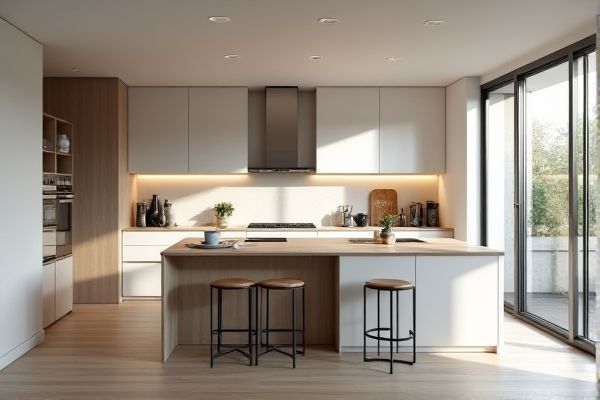
Open base cabinets offer easy access and a more airy, modern feel ideal for displaying kitchenware or frequently used items, while closed base cabinets provide a cleaner look with concealed storage, protecting items from dust and creating a streamlined appearance. Discover which option best suits Your kitchen design and functionality needs by reading the rest of this article.
Table of Comparison
| Feature | Open Base Cabinets | Closed Base Cabinets |
|---|---|---|
| Design | Exposed shelving, visible storage | Fully enclosed, concealed storage |
| Accessibility | Easy access to items | Items hidden behind doors |
| Storage Capacity | Limited, ideal for display | Maximized, ideal for hidden storage |
| Maintenance | Requires frequent dusting | Less dust accumulation |
| Aesthetic | Casual, modern look | Clean, traditional appearance |
| Cost | Generally less expensive | Often higher cost due to materials |
| Installation | Simpler, faster setup | More complex, time-consuming |
Introduction to Base Cabinets: Open vs Closed
Open base cabinets provide easy access and a modern aesthetic by featuring exposed shelving or simple frames, making them ideal for frequently used items. Closed base cabinets offer concealed storage behind doors or drawers, protecting contents from dust and delivering a streamlined, tidy appearance. Your choice between open and closed base cabinets should consider both functionality and the visual impact on your kitchen or workspace layout.
Design Differences Between Open and Closed Base Cabinets
Open base cabinets feature exposed shelving or legs, offering a more airy and accessible design that suits modern or minimalist interiors. Closed base cabinets have solid panels that provide a seamless and enclosed look, often preferred for traditional or formal kitchen styles. Your choice affects both the aesthetic appeal and storage functionality, as open bases highlight display opportunities while closed bases ensure concealed storage.
Aesthetic Appeal: Open vs Closed Cabinets
Open base cabinets create a visually airy and spacious kitchen design by showcasing dishware and decorative items, enhancing aesthetic appeal with easy access and personalized display. Closed base cabinets offer a sleek, uniform look by concealing storage contents, contributing to a clean, minimalist aesthetic that hides clutter. Choosing between open and closed base cabinets directly impacts the kitchen's overall style, balancing openness and organization with design preferences and practical needs.
Storage Accessibility and Organization
Open base cabinets offer superior storage accessibility by allowing easy reach and visibility of items, promoting quick retrieval and efficient use of space. Closed base cabinets provide better organization by concealing contents behind doors, reducing visual clutter and protecting stored goods from dust. Selecting between open and closed base cabinets depends on the balance desired between accessibility and a neat, organized appearance in kitchen or workspace design.
Space Utilization and Flexibility
Open base cabinets maximize space utilization by providing easy access and customizable storage options, making them ideal for frequently used items. Closed base cabinets offer better protection for stored goods and create a cleaner look but may limit flexibility due to fixed shelving. Your choice depends on whether you prioritize adaptable storage or a more organized, concealed appearance.
Maintenance and Cleaning Considerations
Open base cabinets offer easier access for cleaning floors and corners, reducing dust and debris buildup compared to closed base cabinets, which can trap dirt underneath. Closed base cabinets require more frequent and thorough cleaning inside the enclosed spaces to prevent mold, pests, and accumulation of grime. Your choice between open and closed base cabinets will impact the time and effort needed to maintain a spotless kitchen environment.
Cost Comparison: Open vs Closed Base Cabinets
Open base cabinets generally cost less than closed base cabinets due to reduced material usage and simpler construction. Closed base cabinets require additional panels, doors, and hardware, increasing both material and labor expenses. For budget-conscious kitchen renovations, open base cabinets offer a cost-effective option without sacrificing functionality.
Suitability for Different Room Types
Open base cabinets enhance airiness and accessibility, making them ideal for small kitchens and casual dining areas where a spacious feel is desired. Closed base cabinets provide concealed storage and a polished look, fitting well in formal kitchens, bathrooms, and utility rooms that require clutter-free organization. Choosing between open and closed base cabinets depends on the room's function, storage needs, and design preference.
Durability and Longevity Factors
Open base cabinets offer easy access and ventilation, reducing moisture buildup that can cause mold and warping, potentially enhancing durability in humid environments. Closed base cabinets provide better protection against dust, pests, and accidental impacts, often resulting in longer lifespan due to their enclosed construction and sturdy materials. Choosing between the two depends on your kitchen's climate conditions and maintenance preferences to maximize durability and longevity.
Choosing the Right Base Cabinet for Your Needs
Open base cabinets provide easy access and a spacious feel, ideal for kitchens prioritizing convenience and visual openness. Closed base cabinets offer concealed storage, protecting items from dust and creating a sleek, organized appearance preferred in traditional or minimalist designs. Selecting the right base cabinet depends on your storage needs, kitchen size, and style preferences, balancing practicality with aesthetic goals.
 homyna.com
homyna.com